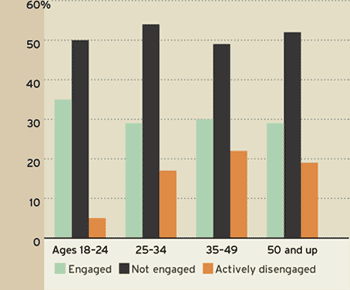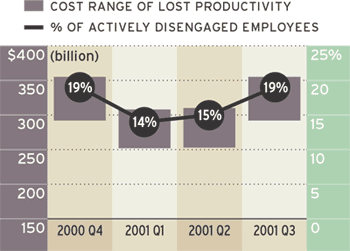Talk of Ages
Young or old, workers are about equally dedicated to their jobs
The best and the brightest in any workplace are bound to share
certain traits, such as a sense of responsibility and a positive
attitude. But one thing they won't have in common is their ages.
That's because highly dedicated employees are found across the age
spectrum. In GMJ's fourth national survey of U.S. workers, the
percentage who say they are engaged, or deeply involved in their
work, varied only slightly by age group: 35% of workers ages 18 to
24 are engaged; as are 29% ages 25 to 34; 30% ages 35 to 49; and
29% ages 50 and older.
The level of engagement is important because Gallup research
shows that engaged employees are more productive than their
disengaged colleagues. (That same research shows that employees are
engaged when an employer meets their basic needs, including
respect, praise, constructive criticism and the opportunity to
contribute.)
So, what might we learn about boosting engagement by examining
some workplace attitudes of different age groups? As it turns out,
age groups vary significantly in their view of the workplace as a
meritocracy: Only about a quarter of workers age 25 or older
strongly believe that promotion is based on ability, compared with
40% of 18- to 24-year-olds. And only about a quarter to a third of
workers age 25 or older trust their company to be fair to all
employees, compared with 45% of younger workers.
If the older workers' more jaded view truly reflects their
experience, managers should be able to boost engagement by
asserting that their companies are committed to fairness. That
doesn't mean everyone who wants a promotion will get one. But it
does require managers to recognize all employees appropriately.
Doing so is more than just good management, it's the bedrock of
engagement. And as is evident from the chart showing the cost of
disengagement, an engaged workforce is something no company can
afford to be without.
|
|
| PERCENTAGE OF
EMPLOYEES BY AGE |
|
 |
|
|
| PERCENTAGE OF
EMPLOYEES WHO STRONGLY AGREE |
|
 |
| THE COST OF
DISENGAGEMENT |
|
| PERCENTAGE OF
ACTIVELY DISENGAGED EMPLOYEES |
|
 |
| Results of these surveys are based on
nationally representative samples of about 1,000 employed adults
age 18 or older. Interviews were conducted by telephone from
October 2000 to August 2001 by The Gallup Organization. For results
based on samples of this size, one can say with 95% confidence that
the error attributable to sampling and other random effects could
be plus or minus three percentage points. For findings based on
subgroups, the sampling error would be greater. |
|


